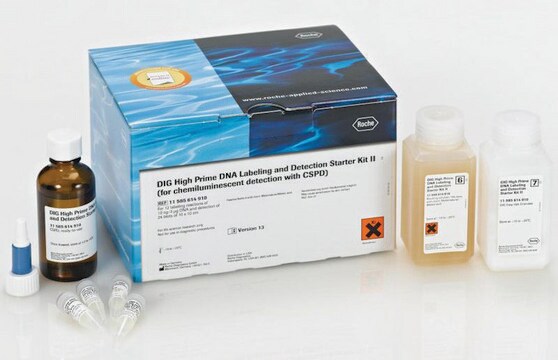11585592001
Roche
High Prime
solution, sufficient for 50 labeling reactions, pkg of 200 μL
Synonym(s):
high prime, labeling mix
Sign Into View Organizational & Contract Pricing
All Photos(2)
About This Item
UNSPSC Code:
41105500
Recommended Products
form
solution
Quality Level
usage
sufficient for 50 labeling reactions
packaging
pkg of 200 μL
manufacturer/tradename
Roche
storage temp.
−20°C
General description
Contents:
5x concentrated random primer mix: 1 U/μl Klenow polymerase, labeling grade, 0.125 mM dATP, 0.125 mM dGTP, 0.125 mM dTTP in 50% (v/v) glycerol.
5x concentrated random primer mix: 1 U/μl Klenow polymerase, labeling grade, 0.125 mM dATP, 0.125 mM dGTP, 0.125 mM dTTP in 50% (v/v) glycerol.
Enzyme and nucleotide mixture for rapid random-primed labeling of DNA with [32P], [35S], or [3H] dCTP. In this method, the complementary DNA strand of denatured DNA is synthesized by Klenow polymerase using the 3′-OH termini of the random oligonucleotides as primers.
High Prime is used for rapid random-primed labeling of DNA with [32P], [35S], or [3H]dCTP to a guaranteed specific activity of >2 x 109 dpm/μg. Incubation time is only 10 minutes at +37°C.
High Prime guarantees efficient labeling of:
High Prime guarantees efficient labeling of:
- DNA amounts ranging from 10 ng to 3 μg in a standard reaction
- DNA of different lengths ranging from small restriction fragments to l or cosmid DNA
- DNA, supercoiled or linearized
- DNA in low melting-point agarose.
High Prime, a novel labeling mixture, contains optimal concentrations of nucleotides and primers in a highly efficient reaction mix with Klenow enzyme. This convenient "all-in-one" principle of High Prime reduces pipetting steps to a minimum, and increases accuracy and reproducibility of labeling reactions.
Specificity
Heat inactivation: Stop the reaction by adding 2 μl 0.2 M EDTA (pH 8.0) and/or by heating to 65 °C for 10 minutes.
Application
For the labelling of DNA with radioactive dCTP using random oligonucleotides as primers.
High Prime-labelled probes are used in a variety of hybridization techniques: Southern blots
High Prime has been used to label the probes by random hexamer labelling and labelling of probes with 32P by random priming.
High Prime-labelled probes are used in a variety of hybridization techniques: Southern blots
- Northern blots
- Dot/slot blots
- Screening of gene libraries
- In situ hybridizations
High Prime has been used to label the probes by random hexamer labelling and labelling of probes with 32P by random priming.
Quality
Function tested in the standard assay.
Principle
Labeled probes are generated with High Prime according to the random-primed labeling technique. High Prime is a specifically developed reaction mixture containing random oligonucleotides, Klenow polymerase, labeling grade, dATP, dGTP, and dTTP in an optimized reaction buffer concentrate in 50% glycerol for rapid and efficient labeling of DNA with [32P]-, [35S]-, or [3H]-labeled dCTP.
Analysis Note
Specific Activity: The standard assay routinely yields a specific activity of 2 x 109 dpm/μg, using different substrate DNAs after 10 minutes of incubation.
Assay Time: 30 minutes
Sample Materials
Assay Time: 30 minutes
Sample Materials
- DNA fragments of at least 100 bp
- Linearized plasmid, cosmid or λDNA
- Supercoiled DNA
- Or minimal amounts of DNA (10 ng), e.g., DNA restriction fragments isolated from gels or in molten agarose
Other Notes
For life science research only. Not for use in diagnostic procedures.
Storage Class
12 - Non Combustible Liquids
wgk_germany
WGK 1
flash_point_f
No data available
flash_point_c
No data available
Certificates of Analysis (COA)
Search for Certificates of Analysis (COA) by entering the products Lot/Batch Number. Lot and Batch Numbers can be found on a product’s label following the words ‘Lot’ or ‘Batch’.
Already Own This Product?
Find documentation for the products that you have recently purchased in the Document Library.
Pof8 is a La-related protein and a constitutive component of telomerase in fission yeast
Paez-Moscoso DJ, et al.
Nature Communications, 9(1), 587-587 (2018)
Network plasticity of pluripotency transcription factors in embryonic stem cells
Filipczyk A, et al.
Nature Cell Biology, 17(10), 1235-1235 (2015)
Our team of scientists has experience in all areas of research including Life Science, Material Science, Chemical Synthesis, Chromatography, Analytical and many others.
Contact Technical Service
![Adenosine 5′-[γ-thio]triphosphate tetralithium salt ≥75% (HPLC), powder](/deepweb/assets/sigmaaldrich/product/structures/319/398/e29221c2-3649-455b-bd33-583bb017ec7d/640/e29221c2-3649-455b-bd33-583bb017ec7d.png)


